Numerical Simulation of Tehran Dust Storm on 2 June 2014: A Case Study of Agricultural Abandoned Lands as Emission Sources
Abstract
:1. Introduction
2. Materials and Methods
2.1. Case Study Area
2.2. Observed Data
2.3. Numerical Simulation
3. Results
3.1. Description of the Dust Storm from Public Evidence
3.2. Analysis of the Observed Data
3.2.1. Analysis of the Meteorological Stations Data
3.2.2. Analysis of the Airport METAR Data
3.2.3. Analysis of EUMETSAT Images
3.2.4. Analysis of PM Data
3.3. Analysis of the Numerical Simulations Data
- Experiment DHR1: DREAM high-resolution (0.025°, ~3 km) forecast with dust source mask defined using MODIS data (DSM1);
- Experiment DLR1: DREAM low-resolution (0.1°) forecast with dust source mask defined using MODIS data (DSM1);
- Experiment DHR2: DREAM high-resolution (~3 km) forecast with dust source mask defined from dust source map created by Iranian institutions (DSM2);
- Experiment DHR3: DREAM high-resolution (~3 km) forecast with dust source mask defined from dust source map created by Iranian institutions but with selected agricultural surfaces only such as dry farming and abandoned agricultural surfaces (DSM3);
- Experiment WHR: WRF-Chem high-resolution (~3 km) forecast using information on land cover from the model in defining dust source areas.
3.3.1. Analysis of DREAM High-Resolution Forecasts Using Three Versions of Dust Source Masks (Experiments DHR1, DHR2, and DHR3)
3.3.2. Analysis of DREAM Low-Resolution Forecast (Experiment DLR1)
3.3.3. Analysis of WRF-Chem High-Resolution Forecast
4. Discussion
- (a)
- The resolution of the coupled dust-atmospheric model must be of several kilometers to be able to reproduce strong convective activity, which is the essential atmospheric initiator of such storms.
- (b)
- The model domain should be wider than the area of interest because atmospheric processes that lead to the formation of the event happen over a larger domain.
- (c)
- The dust source mask should be designed based on the current information (the bare land fraction should be defined from the latest available information on surface coverage, derived from satellite data, and updated according to the dynamic of land cover change within the domain); information from national (or sub-national, depending on the domain) data on the dust sources and/or soil texture, if available, should be included in defining the dust source masks.
- (d)
- The dust forecast employed over a local domain will not contain information on the intrusion of the dust outside of the model domain, and, if such intrusion is possible, the model boundary conditions must include dust concentrations of some operational dust model in a coarser resolution and of larger domain (for example, the SDS-WAS operational dust forecast); an alternative is to use both forecasts as a complementary material for early warnings.
Supplementary Materials
Author Contributions
Funding
Institutional Review Board Statement
Informed Consent Statement
Data Availability Statement
Acknowledgments
Conflicts of Interest
References
- IPCC. Intergovernmental Panel on Climate Change. Summary for Policymakers. In Climate Change and Land: An IPCC Special Report on Climate Change, Desertification, Land Degradation, Sustainable Land Management, Food Security, and Greenhouse Gas Fluxes in Terrestrial Ecosystems; Shukla, P.R., Skea, J., Calvo Buendia, E., Masson-Delmotte, V., Pörtner, H.-O., Roberts, D.C., Zhai, P., Slade, R., Connors, S., van Diemen, R., Eds.; United Nations, IPCC: Geneva, Switzerland, 2019; ISBN 978-92-9169-154-8. [Google Scholar]
- Goudie, A.S. Desert dust and human health disorders. Environ. Int. 2014, 63, 101–113. [Google Scholar] [CrossRef]
- Sprigg, W.; Nickovic, S.; Galgiani, J.N.; Pejanovic, G.; Petkovic, S.; Vujadinovic, M.; Vukovic, A.; Dacic, M.; DiBiase, S.; Prasad, A.; et al. Regional dust storm modeling for health services: The case of valley fever. J. Aeolian Res. 2014, 14, 53–73. [Google Scholar] [CrossRef] [Green Version]
- Reed, L.; Nugent, K. The health effects of dust storms in the Southwest United States. Southwest Respir. Crit. Care Chron. 2018, 6, 42–46. [Google Scholar] [CrossRef] [Green Version]
- Shao, Y.; Wyrwoll, K.-H.; Chappell, A.; Huang, J.; Lin, Z.; McTainsh, G.H.; Mikami, M.; Tanaka, T.Y.; Wang, X.; Yoon, S. Dust cycle: An emerging core theme in Earth system science. Aeolian Res. 2011, 2, 181–204. [Google Scholar] [CrossRef]
- Shao, Y.; Klose, M.; Wyrwoll, K.-H. Recent global dust trend and connections to climate forcing. J. Geophys. Res. Atmos. 2013, 118, 11107–11118. [Google Scholar] [CrossRef]
- ADEQ. State of Arizona Exceptional Event Documentation for the Events of July 2nd through July 8th 2011, for the Phoenix PM10 Nonattainment Area; Arizona Department of Environmental Quality Maricopa County Air Quality Department, Maricopa Association of Governments: Phoenix, Arizona, 2012. Available online: https://www.epa.gov/sites/production/files/2015-05/documents/az_deq_july_2011_pm10_ee_demo_final_20120308.pdf (accessed on 10 July 2021).
- Pauley, M.P.; Baker, L.N.; Barker, H.E. An observational Study of the “Interstate 5” Dust Storm Case. Bull. Am. Meteor. Soc. 1996, 77, 693–720. [Google Scholar] [CrossRef]
- Birmili, W.; Schepanski, K.; Ansmann, A.; Spindler, G.; Tegen, I.; Wehner, B.; Nowak, A.; Reimer, E.; Mattis, I.; Müller, K.; et al. A case of extreme particulate matter concentrations over Central Europe caused by dust emitted over the southern Ukraine. Atmos. Chem. Phys. 2008, 8, 997–1016. [Google Scholar] [CrossRef] [Green Version]
- Chervenkov, H.; Jakobs, H. Dust storm simulation with regional air quality model—Problems and results. Atmos. Environ. 2011, 45, 3965–3976. [Google Scholar] [CrossRef]
- Cook, B.I.; Miller, R.L.; Seager, R. Amplification of the North American “Dust Bowl” drought through human-induced land degradation. Proc. Natl. Acad. Sci. USA 2009, 106, 4997–5001. [Google Scholar] [CrossRef] [PubMed] [Green Version]
- Alizadeh-Choobari, O.; Ghafarian, P.; Owlad, E. Temporal variations in the frequency and concentration of dust events over Iran based on surface observations. Int. J. Climatol. 2016, 36, 2050–2062. [Google Scholar] [CrossRef]
- Darvishi Boloorani, A.; Najafi, M.S.; Mirzaie, S. Role of land surface parameter change in dust emission and impacts of dust on climate in Southwest Asia. Nat. Hazards 2021. [Google Scholar] [CrossRef]
- Bakhtiari, M.; Darvishi Boloorani, A.; Abdollahi Kakroodi, A.; Rangzan, K.; Mousivand, A. Land degradation modeling of dust storm sources using MODIS and meteorological time series data. J. Arid. Environ. 2021, 190, 104507. [Google Scholar] [CrossRef]
- Fatemi, F.; Moslehi, S.; Ardalan, A. Preparedness functions in disaster: Lesson learned from Tehran dust storm 2014. Nat. Hazards 2015, 77, 177–179. [Google Scholar] [CrossRef]
- Tabarestani, S.; Kamali, G.; Vazifedoust, M.; Sehat Kashani, S. Spectral and synoptic analysis of Haboob in Tehran. Iran. Meteorol. Atmos. Phys. 2021. [Google Scholar] [CrossRef]
- Vukovic, A.; Vujadinovic, M.; Pejanovic, G.; Andric, J.; Kumjian, M.R.; Djurdjevic, V.; Dacic, M.; Prasad, A.K.; El-Askary, H.M.; Paris, B.C.; et al. Numerical simulation of “an American haboob”. Atmos. Chem. Phys. 2014, 14, 3211–3230. [Google Scholar] [CrossRef] [Green Version]
- Terradellas, E.; Basart, S.; Cuevas, E. Airborne Dust: From R&D to Operational Forecast, 2013–2015 Activity Report of the SDS-WAS Regional Center for Northern Africa, Middle East and Europe; Report Number: NIPO: 281-16-007-3; WMO/GAW Report No. 230; WMO/WWRP No. 2016-2; WMO: Geneva, Switzerland, 2016. [Google Scholar]
- Hyde, P.; Mahalov, A.; Li, J. Simulating the meteorology and PM10 concentrations in Arizona dust storms using the Weather Research and Forecasting model with Chemistry (Wrf-Chem). J. Air Waste Manag. Assoc. 2018, 68, 177–195. [Google Scholar] [CrossRef] [PubMed] [Green Version]
- Nickovic, S.; Kallos, G.; Papadopoulos, A.; Kakaliagou, O. A model for prediction of desert dust cycle in the atmosphere. J. Geophys. Res. 2001, 106, 18113–18129. [Google Scholar] [CrossRef] [Green Version]
- Pérez, C.; Nickovic, S.; Baldasano, J.; Sicard, M.; Rocadenbosch, F.; Cachorro, V.E. A long Saharan dust event over the western Mediterranean: Lidar, Sun photometer observations, and regional dust modeling. J. Geophys. Res. 2006, 111, D15214. [Google Scholar] [CrossRef]
- Janjic, Z.I. The Step-Mountain Eta Coordinate Model: Further Developments of the Convection, Viscous Sublayer, and Turbulence Closure Schemes. Mon. Weather Rev. 1994, 122, 927–945. [Google Scholar] [CrossRef] [Green Version]
- Flaounas, E.; Kotroni, V.; Lagouvardos, K.; Klose, M.; Flamant, C.; Giannaros, T. Sensitivity of the WRF-Chem model to different dust emission parametrisation: Assessment in the broader Mediterranean region. Geosci. Model Dev. 2017, 10, 2925–2945. [Google Scholar] [CrossRef] [Green Version]
- Ginoux, P.; Chin, M.; Tegen, I.; Prospero, J.M.; Holben, B.; Dubovik, O.; Lin, S.J. Sources and distributions of dust aerosols simulated with the GOCART model. J. Geophys. Res. Atmos. 2001, 106, 20255–20273. [Google Scholar] [CrossRef]
- Sanz, M.J.; de Vente, J.; Chotte, J.-L.; Bernoux, M.; Kust, G.; Ruiz, I.; Almagro, M.; Alloza, J.-A.; Vallejo, R.; Castillo, V.; et al. Sustainable Land Management contribution to successful land-based climate change adaptation and mitigation. In A Report of the Science-Policy Interface; United Nations Convention to Combat Desertification (UNCCD): Bonn, Germany, 2017; ISBN 978-92-95110-96-0. [Google Scholar]
- UNCCD United Nations Convention to Combat Desertification. The Global Land Outlook, 1st ed.; United Nations: Bonn, Germany, 2017; ISBN 978-92-95110-48-9. [Google Scholar]
- UNEP; WMO; UNCCD. Global Assessment of Sand and Dust Storms; United Nations Environment Programme: Nairobi, Kenya, 2016; ISBN 978-92-807-3551-2. [Google Scholar]
- Bullard, J.E.; Baddock, M.; Bradwell, T.; Crusius, J.; Darlington, E.; Gaiero, D.; Gassó, S.; Gisladottir, G.; Hodgkins, R.; McCulloch, R.; et al. High-latitude dust in the earth system. Rev. Geophys. 2016, 54, 447–485. [Google Scholar] [CrossRef] [Green Version]
- Kavan, J.; Láska, K.; Nawrot, A.; Wawrzyniak, T. High Latitude Dust Transport Altitude Pattern Revealed from Deposition on Snow, Svalbard. Atmosphere 2020, 11, 1318. [Google Scholar] [CrossRef]
- Middleton, N.; Kang, U. Sand and Dust Storms: Impact Mitigation. Sustainability 2017, 9, 1053. [Google Scholar] [CrossRef] [Green Version]
- Middleton, N. Rangeland management and climate hazards in drylands: Dust storms, desertification and the overgrazing debate. Nat. Hazards 2018, 92, 57–70. [Google Scholar] [CrossRef] [Green Version]
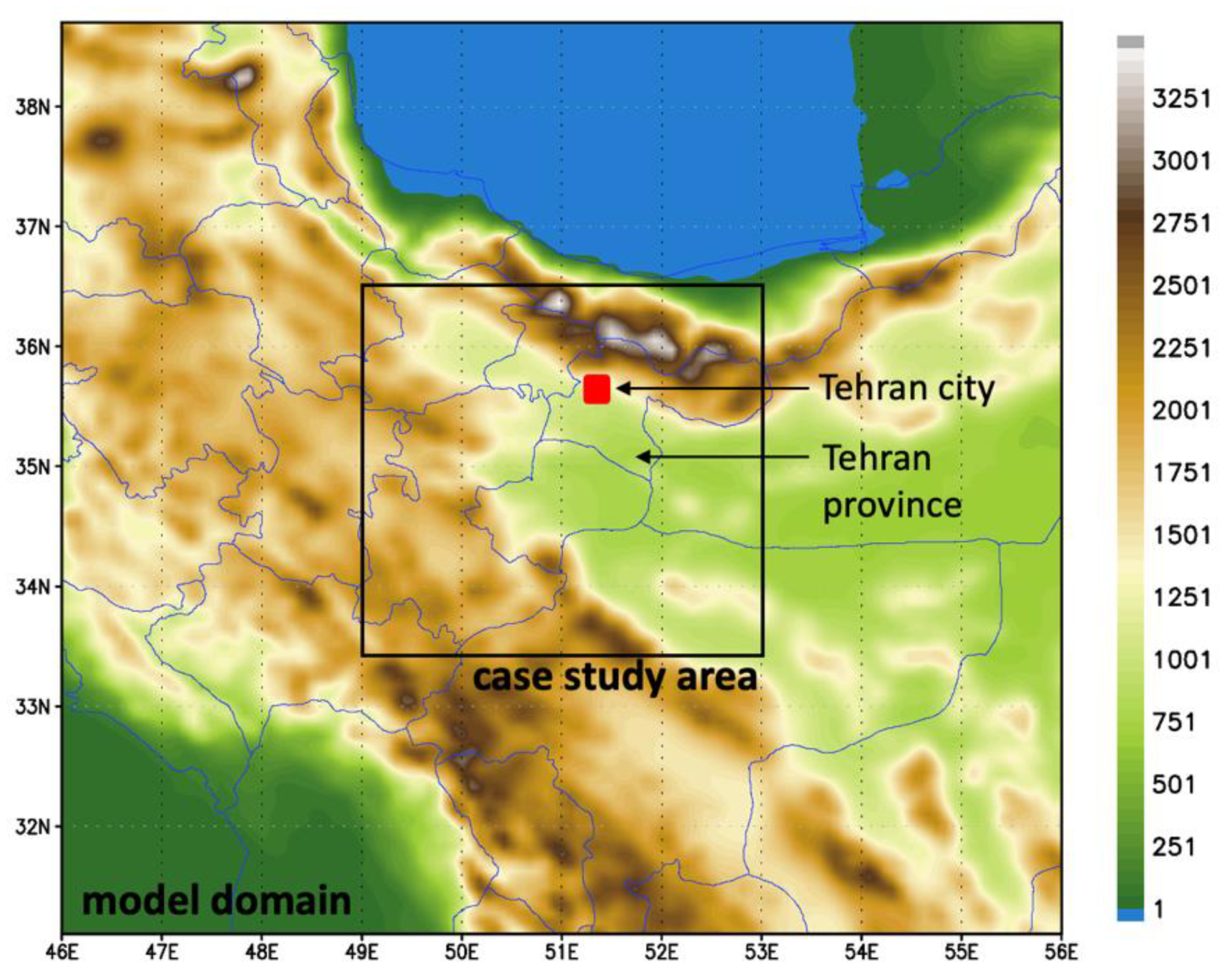


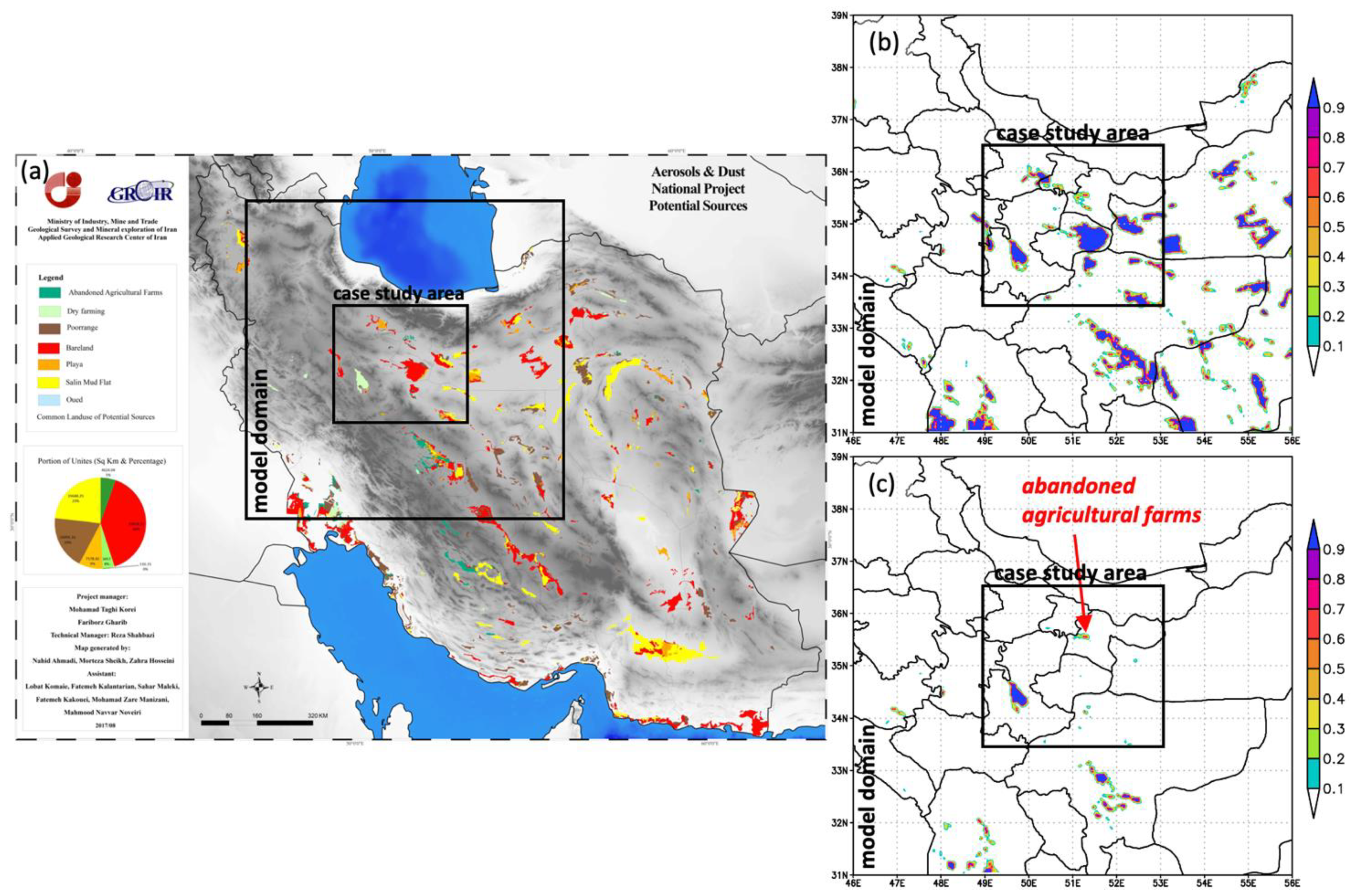
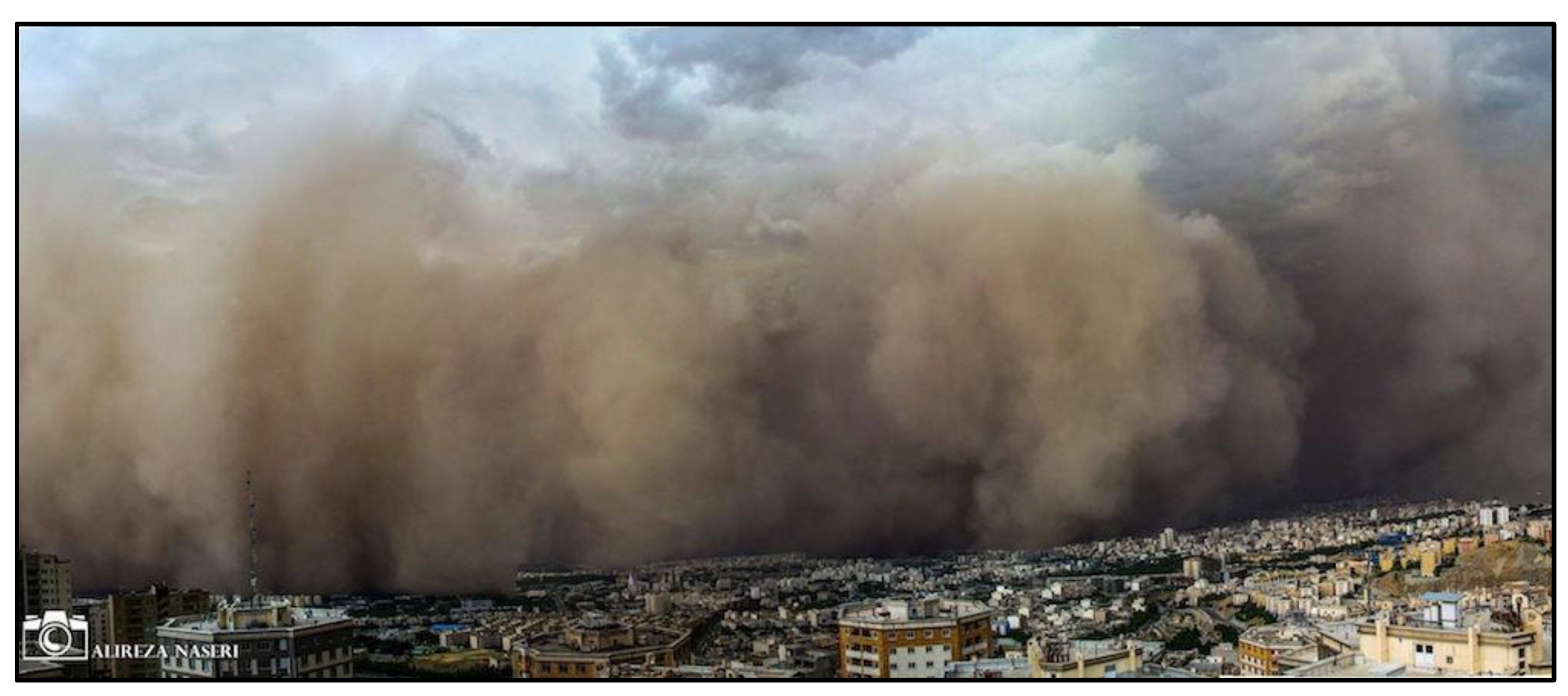
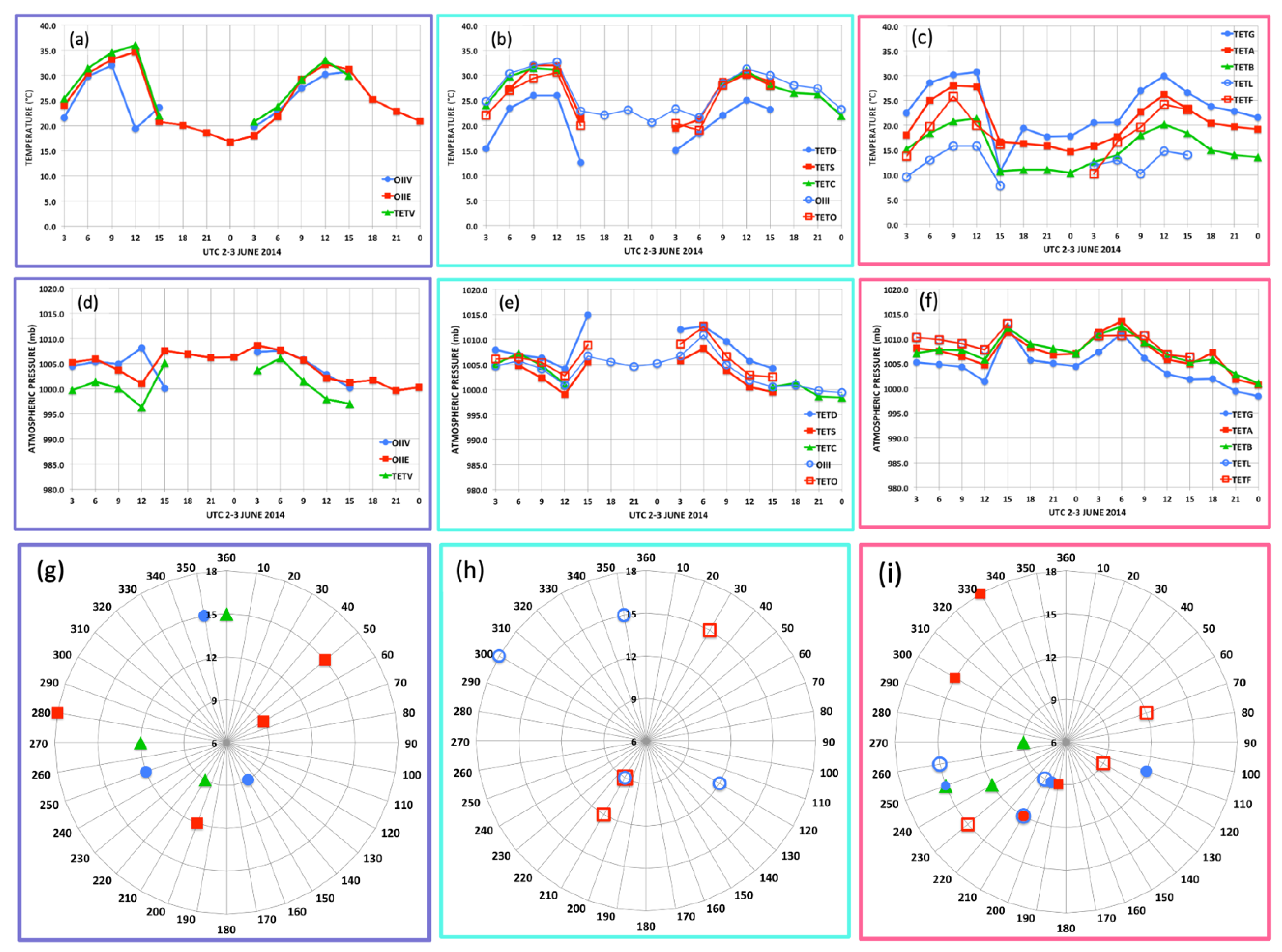

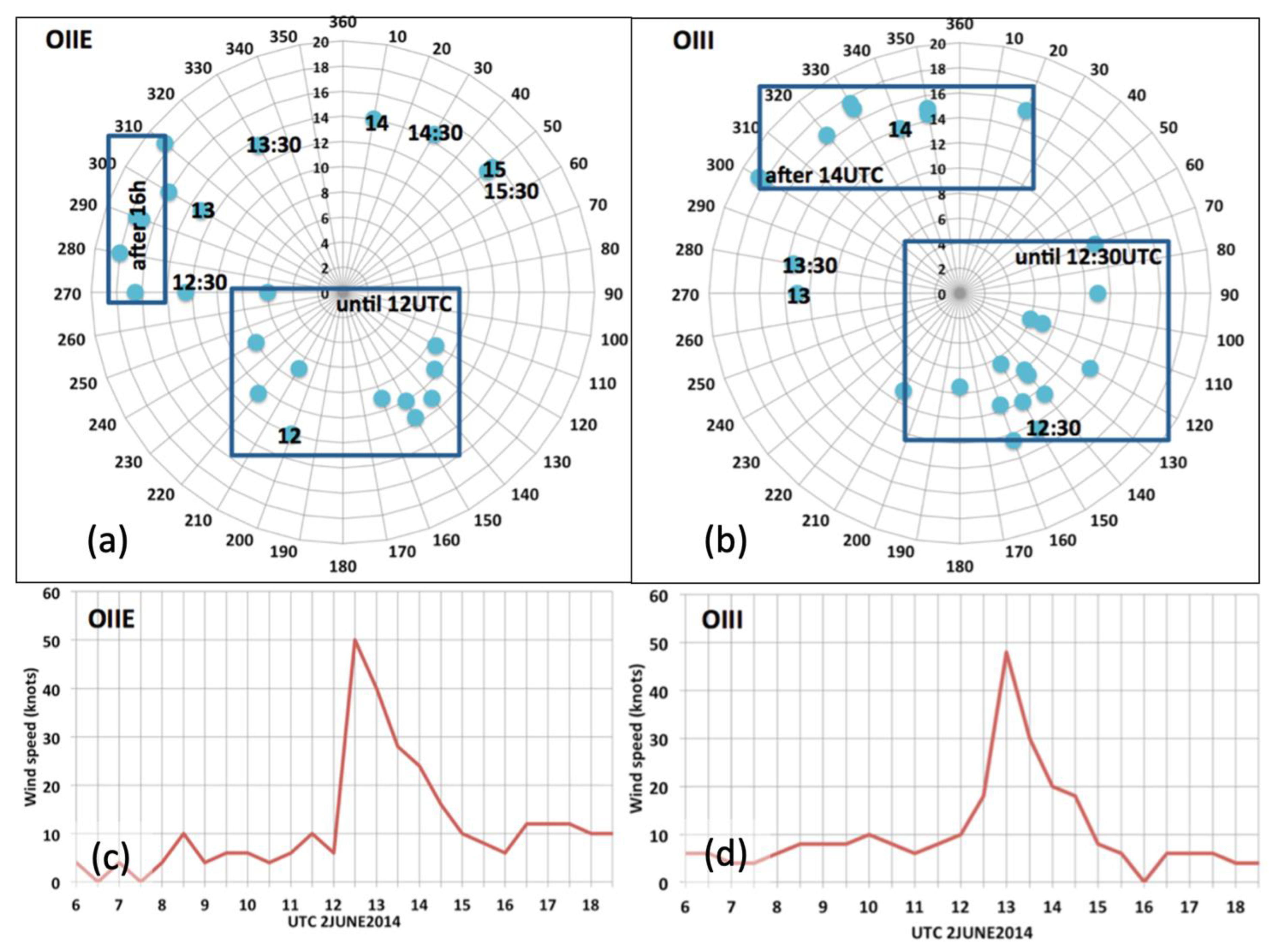
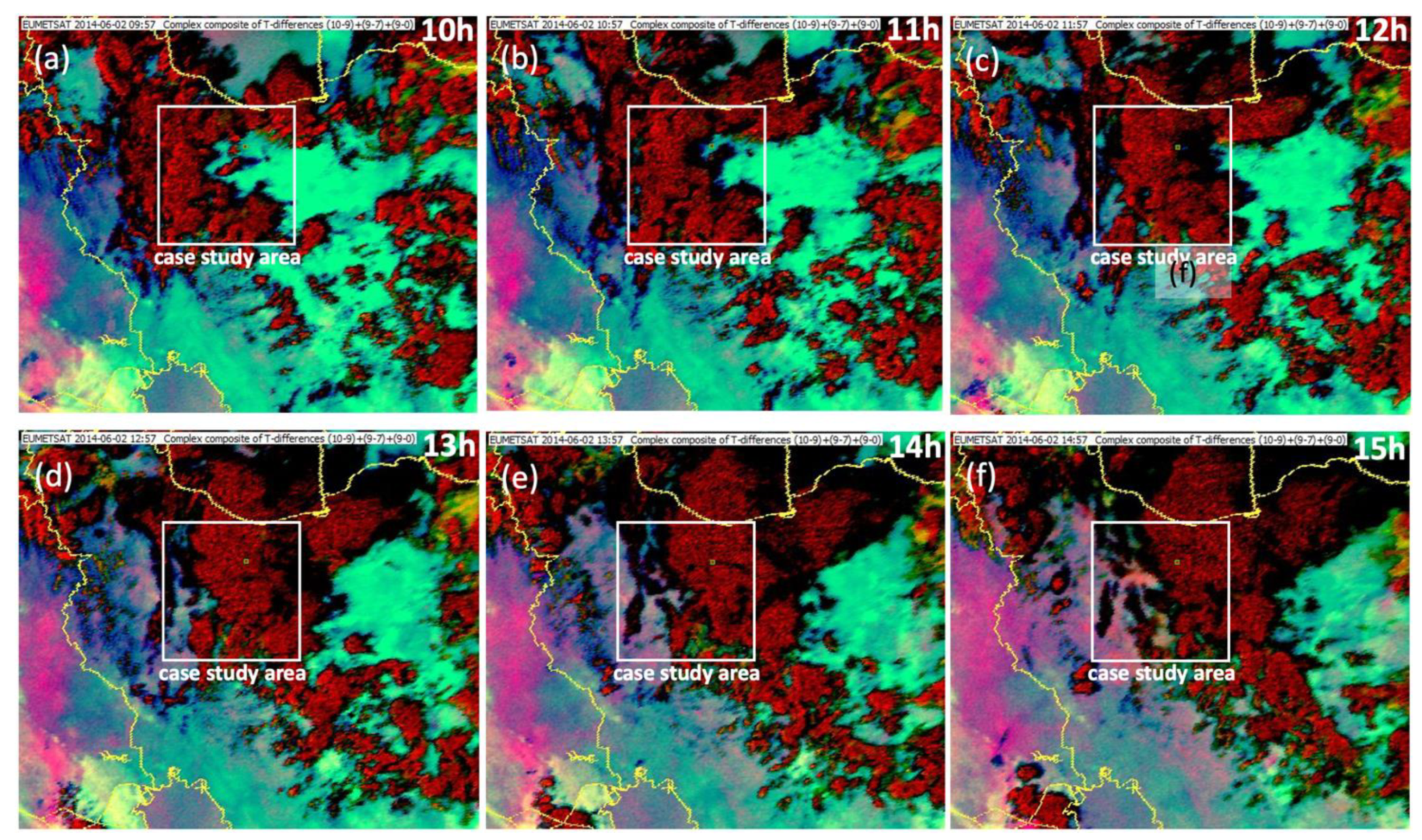
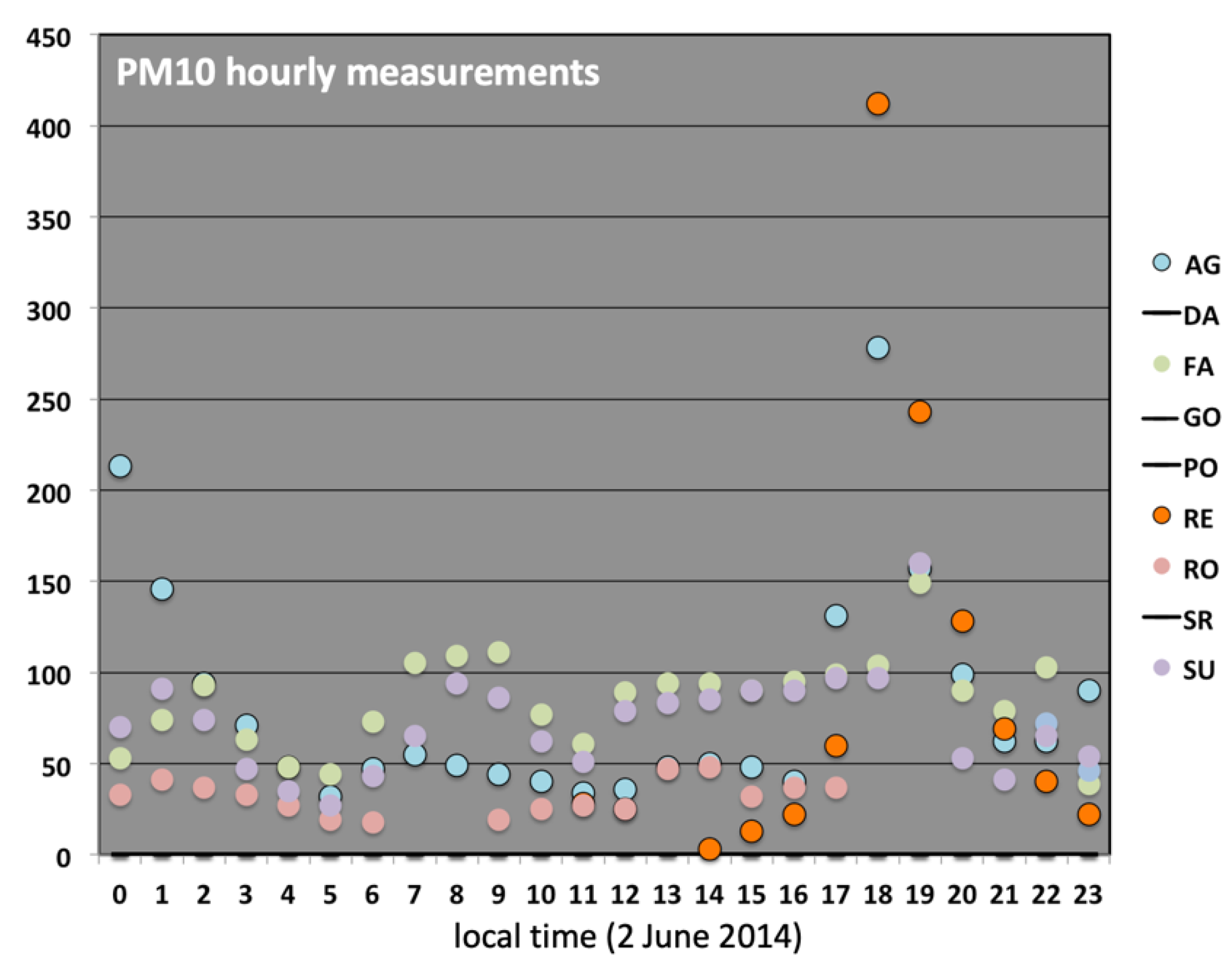
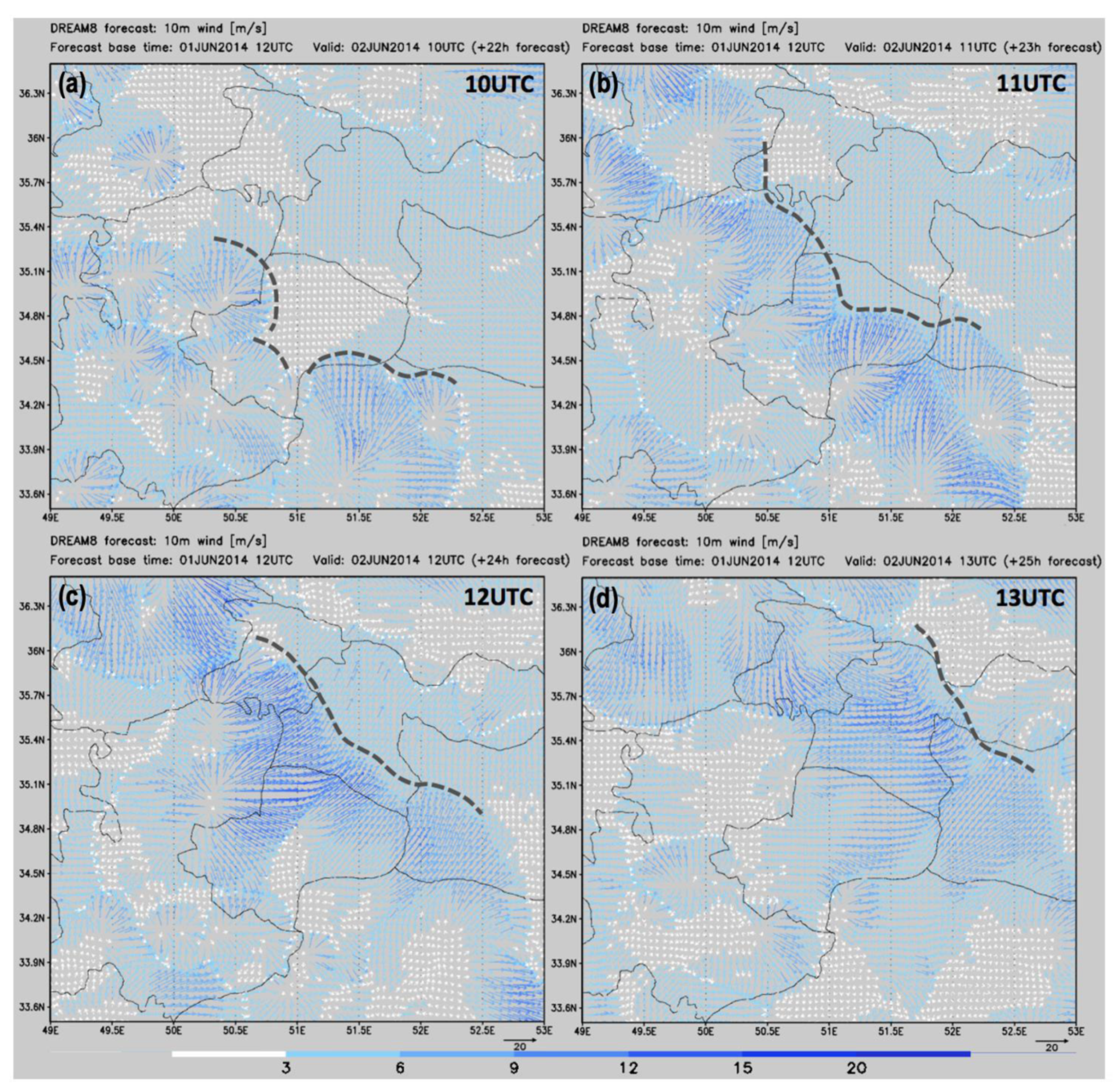

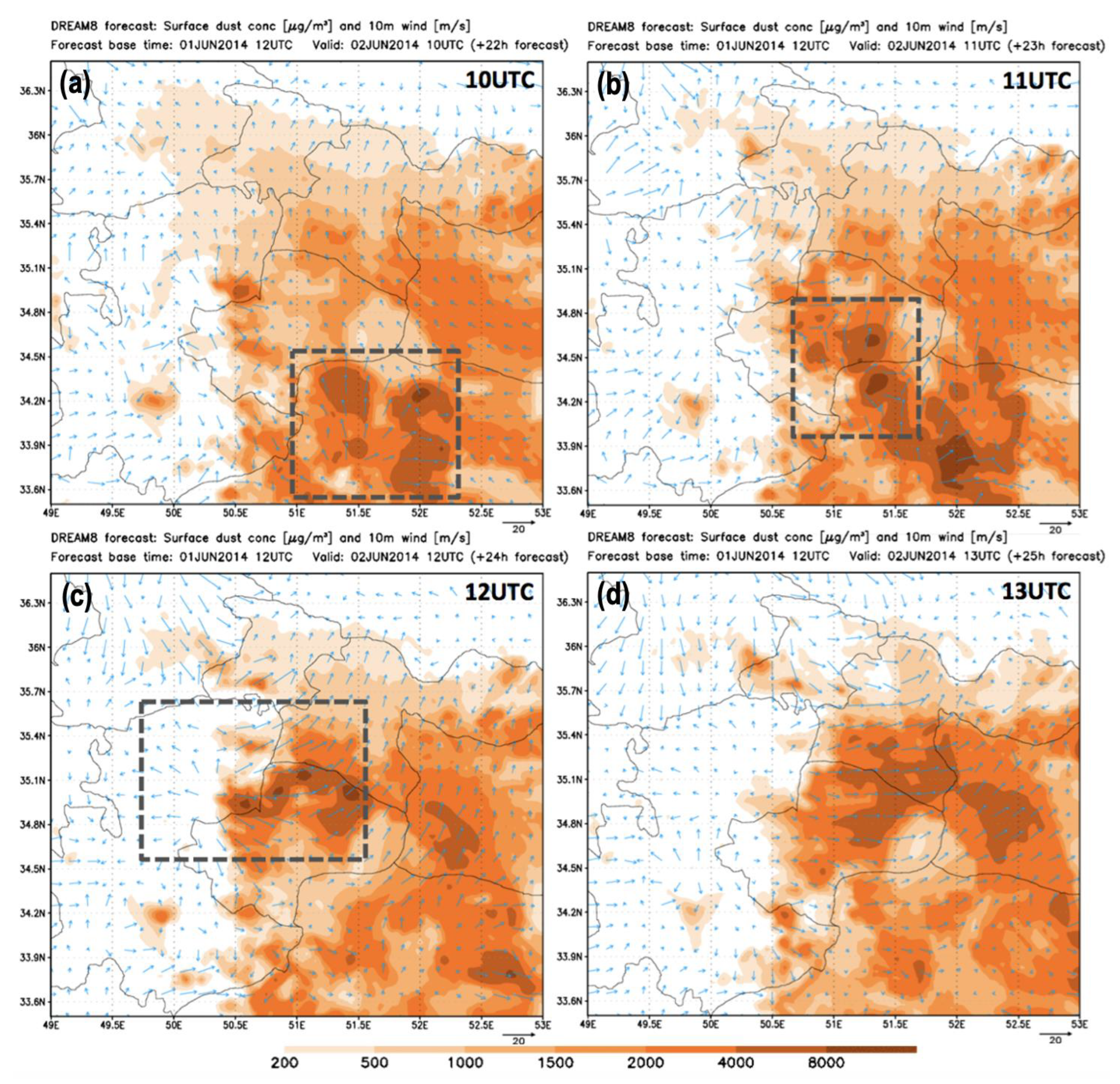

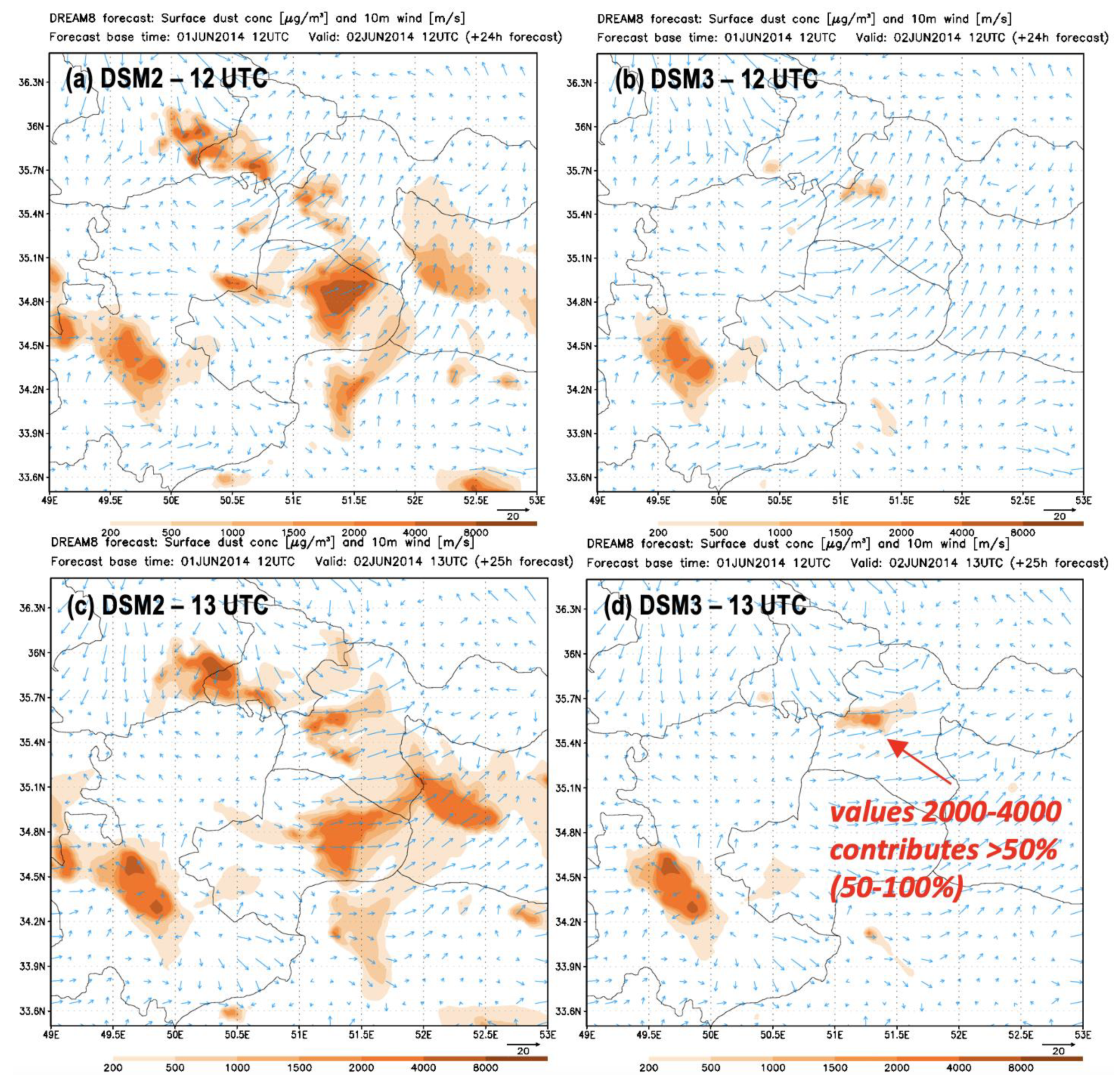
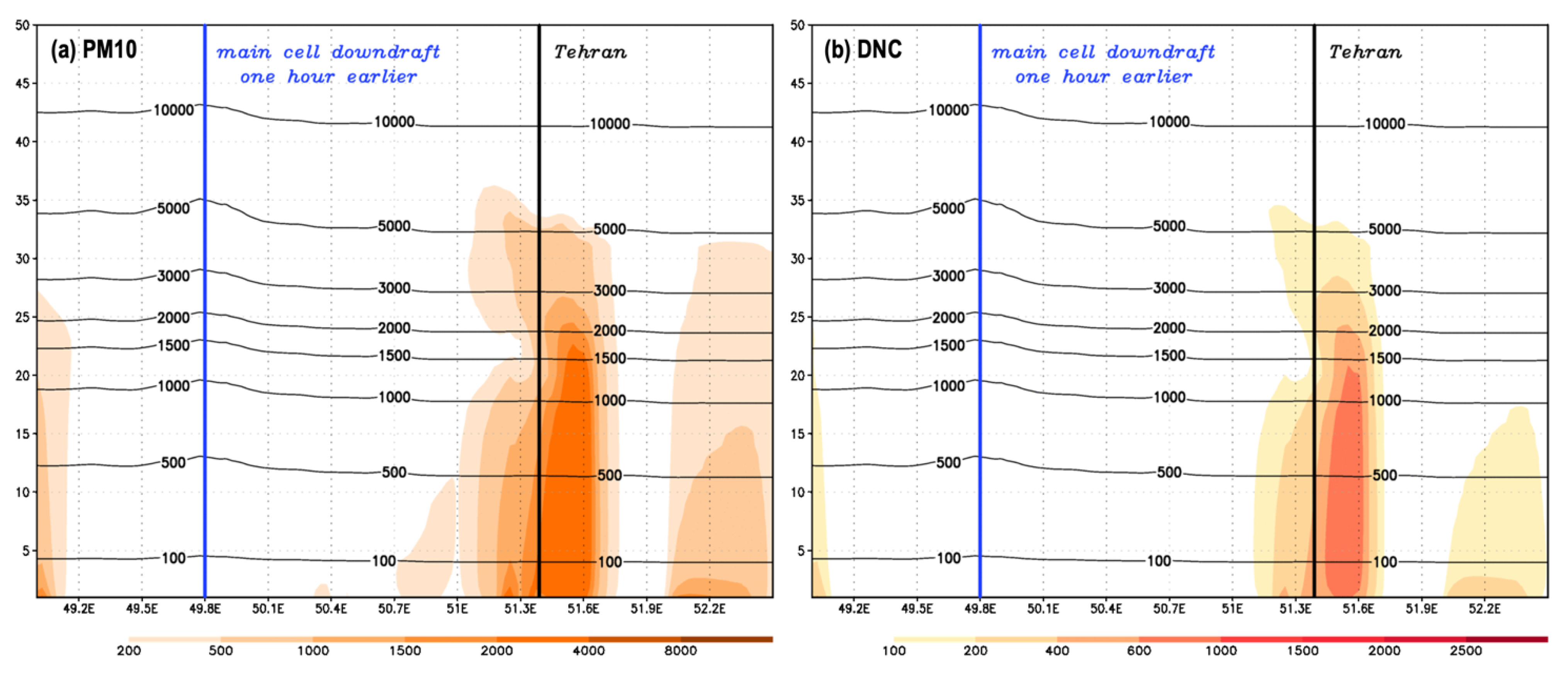
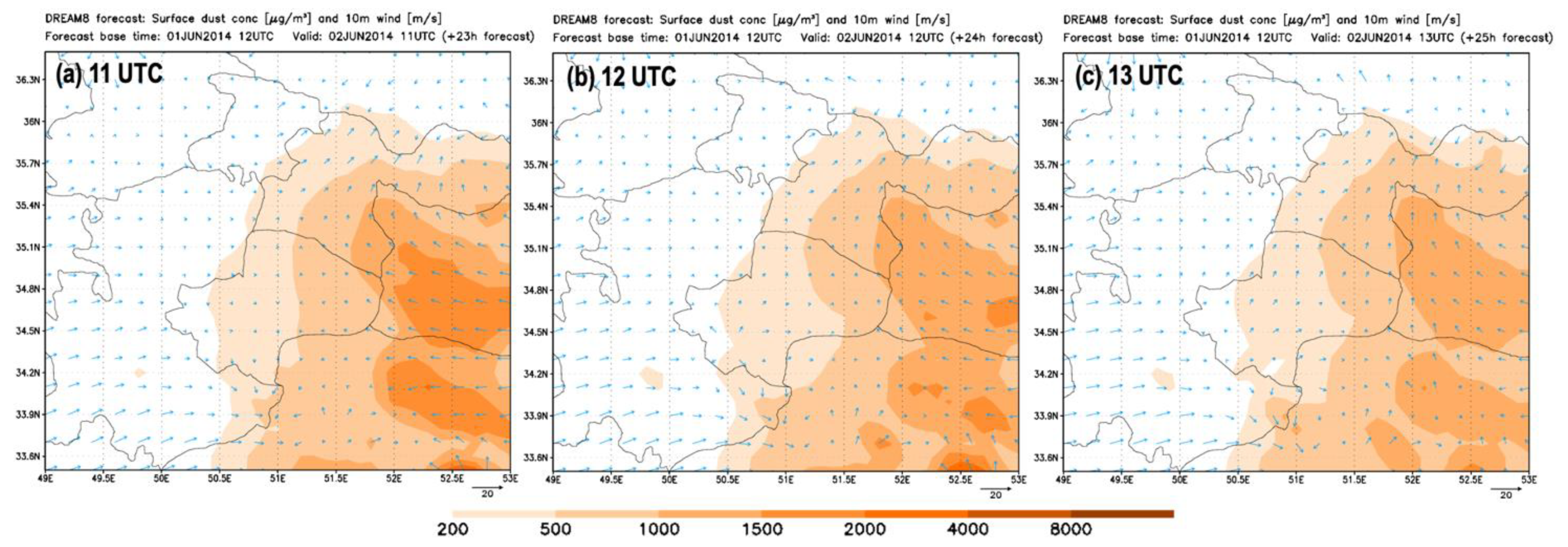

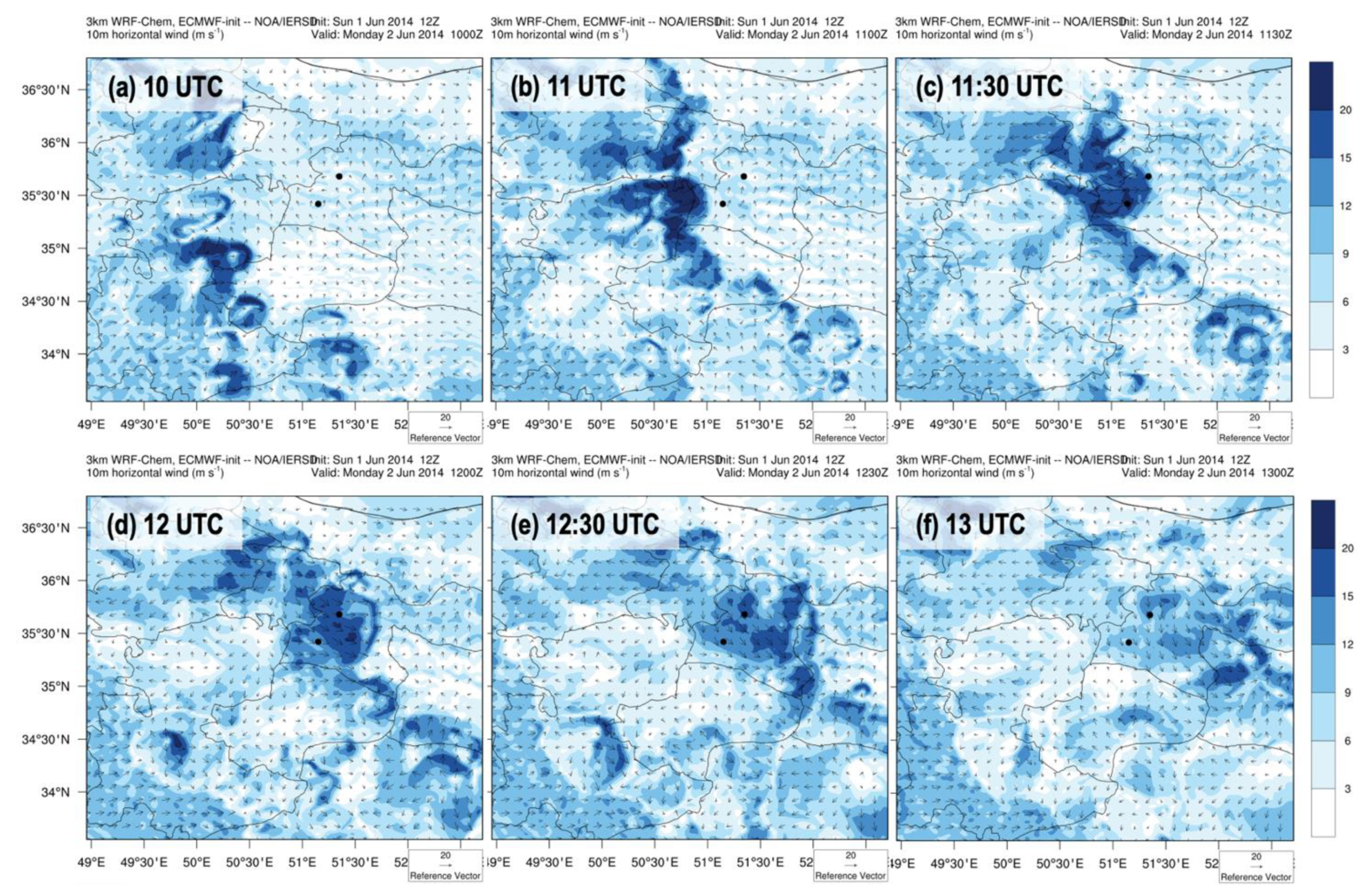
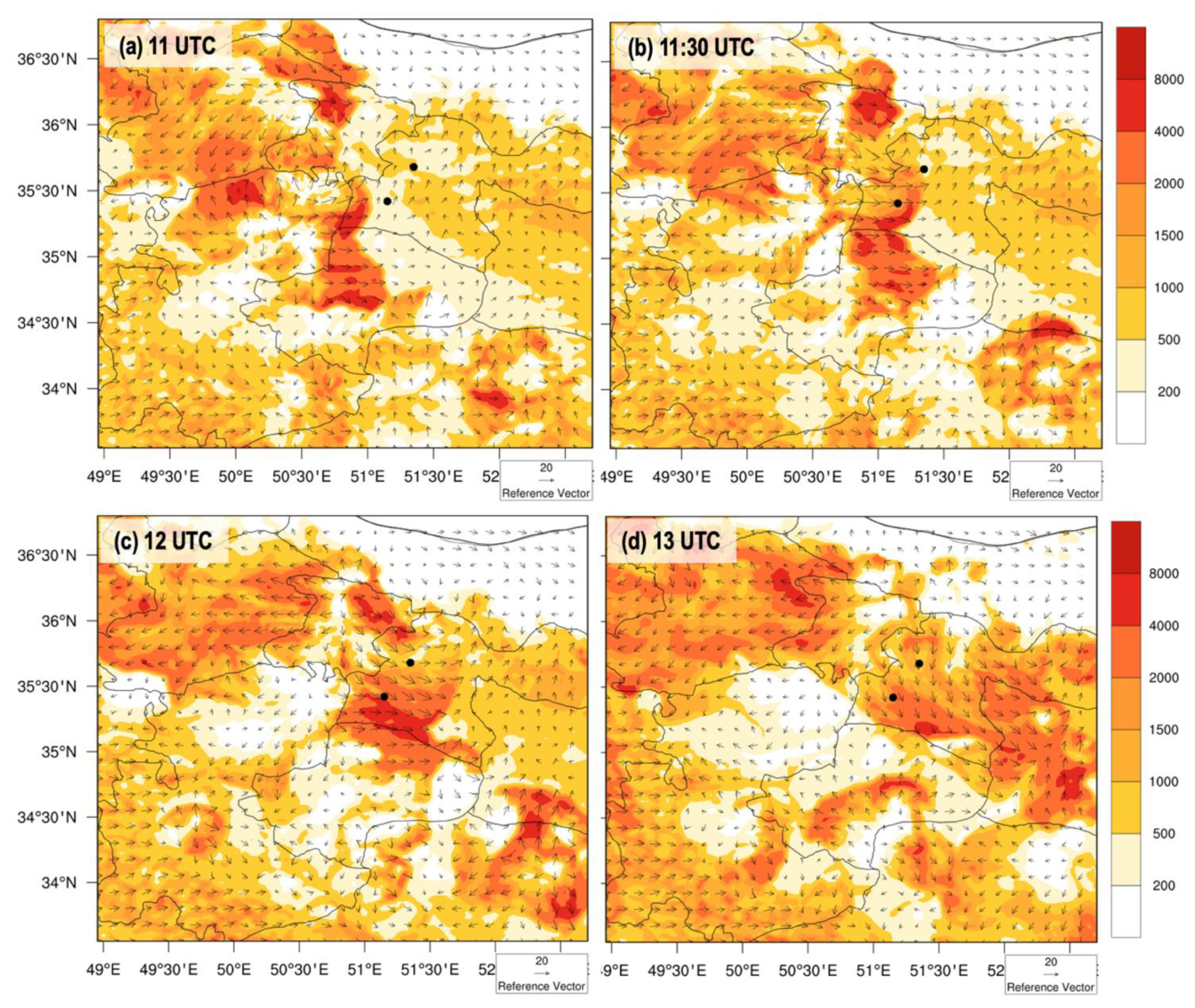
| Code | Name | Acr. | Lat. (° N) | Lon. (° E) | El. (m) | Data |
|---|---|---|---|---|---|---|
| 40751 | Tehran (Shemiran) | TETG | 35.78 | 51.62 | 1549 | every 3 h |
| 40754 | Tehran (Mehrabad) * | OIII | 35.68 | 51.32 | 1191 | every 3 h |
| 40755 | Abali | TETB | 35.75 | 51.88 | 2465 | every 3 h |
| 40756 | Firoozkooh | TETF | 35.92 | 52.83 | 1976 | available 03–15 UTC |
| 40777 | Imam Khomeini Airport * | OIIE | 35.42 | 51.17 | 990 | every 3 h |
| 99320 | Chitgar | TETC | 35.70 | 51.13 | 1305 | missing 15 h (2 June)–06 h (3 June) UTC |
| 99331 | Tehran (Geophysics) | TETO | 35.73 | 51.38 | 1419 | available 03–15 UTC |
| 99366 | Lavasan | TETA | 35.83 | 51.64 | 1863 | every 3 h; visibility available 03–15 h UTC |
| 99369 | Damavand | TETD | 35.72 | 50.83 | 2051 | available 03–15 UTC |
| 99370 | Firoozkooh Aminabad (GAW station) | TETL | 35.72 | 52.40 | 2986 | available 03–15 UTC |
| 99372 | Saveh | OIIV | 35.05 | 50.33 | 1112 | available 03–15 UTC |
| 99375 | Shahryar | TETS | 35.67 | 51.03 | 1163 | available 03–15 UTC |
| 99406 | Varamin | TETV | 35.32 | 51.65 | 973 | available 03–15 UTC |
| Name | Acr. | Lat. (° N) | Lon. (° E) | Data |
|---|---|---|---|---|
| Aghdasyeh | AG | 35.79587 | 51.48414 | data available |
| Darous | DA | 35.77000 | 51.45416 | no data |
| Fath | FA | 35.67882 | 51.33753 | data available |
| Golbarg | GO | 35.73103 | 51.50613 | no data |
| Poonak | PO | 35.76230 | 51.33168 | no data |
| Region 2 | RE | 35.77709 | 51.36818 | data available |
| Shahre Rey | SR | 35.60363 | 51.42571 | no data |
| Sharif University | SU | 35.70227 | 51.35094 | data available |
| Rose Park | RO | 35.73989 | 51.26789 | no data after 17 h l.t. |
Publisher’s Note: MDPI stays neutral with regard to jurisdictional claims in published maps and institutional affiliations. |
© 2021 by the authors. Licensee MDPI, Basel, Switzerland. This article is an open access article distributed under the terms and conditions of the Creative Commons Attribution (CC BY) license (https://creativecommons.org/licenses/by/4.0/).
Share and Cite
Vukovic Vimic, A.; Cvetkovic, B.; Giannaros, T.M.; Shahbazi, R.; Sehat Kashani, S.; Prieto, J.; Kotroni, V.; Lagouvardos, K.; Pejanovic, G.; Petkovic, S.; et al. Numerical Simulation of Tehran Dust Storm on 2 June 2014: A Case Study of Agricultural Abandoned Lands as Emission Sources. Atmosphere 2021, 12, 1054. https://doi.org/10.3390/atmos12081054
Vukovic Vimic A, Cvetkovic B, Giannaros TM, Shahbazi R, Sehat Kashani S, Prieto J, Kotroni V, Lagouvardos K, Pejanovic G, Petkovic S, et al. Numerical Simulation of Tehran Dust Storm on 2 June 2014: A Case Study of Agricultural Abandoned Lands as Emission Sources. Atmosphere. 2021; 12(8):1054. https://doi.org/10.3390/atmos12081054
Chicago/Turabian StyleVukovic Vimic, Ana, Bojan Cvetkovic, Theodore M. Giannaros, Reza Shahbazi, Saviz Sehat Kashani, Jose Prieto, Vassiliki Kotroni, Konstantinos Lagouvardos, Goran Pejanovic, Slavko Petkovic, and et al. 2021. "Numerical Simulation of Tehran Dust Storm on 2 June 2014: A Case Study of Agricultural Abandoned Lands as Emission Sources" Atmosphere 12, no. 8: 1054. https://doi.org/10.3390/atmos12081054









